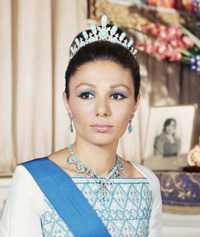
Her Imperial Majesty Farah Pahlavi, Shahbanou of Iran was born in Tehran on October 14, 1938, the only child of Mr. Sohrab Diba and Farideh Diba Ghotbi .
Following the death of her father in 1947, Farah Pahlavi was educated at the Italian School and later the Jeanne D’Arc School. She obtained her baccalaureate from the Lycee Razi, a secular Persian and French High School in Tehran.
Farah Pahlavi was studying architecture in Paris in 1959 when she was introduced to Mohammad Reza Shah Pahlavi of Iran at an embassy reception. The couple’s engagement was announced on December 1 and they were married three weeks later. Empress Farah gave birth to Crown Prince Reza in 1960, Princess Farahnaz in 1963, Prince Alireza in 1966 and Princess Leila in 1970.
In the 1960s and ‘70s Empress Farah traveled widely within Iran to support her husband’s social and economic reforms to advance the rights of women and children, the disabled and the handicapped, culture and the arts, science and medicine, and architecture and the environment. Under the patronage of the Farah Pahlavi Foundation she financially supported a network of museums, art centers and dozens of charities. She worked tirelessly to champion Iranian culture and the arts and to encourage community-based village enterprises to revitalize traditional handicrafts. She established a series of landmark events to celebrate contemporary and modern Iranian art and culture including the Shiraz Festival of Arts, the Isfahan Festival of Popular Traditions, the Kerman Traditional Music Festival, the Tehran International Film Festival and the Children’s Film Festival. Empress Farah spearheaded an effort to promote children’s literacy by establishing children’s libraries in the cities and the countryside. She put her training as an architect to good use when she lobbied to save mosques and historic buildings from demolition, and by preserving open land from development so that parks and green spaces became a feature of crowded urban centers. She headed up the South Tehran Redevelopment Corporation which aimed to alleviate poverty and improve living conditions in Tehran’s southern suburbs.
Empress Farah broke many barriers during her two decades on the throne. She was Iran’s first crowned female sovereign and the first woman crowned anywhere in the Muslim world. She was the first woman in a Muslim country to publicly donate blood. As her husband’s ambassador abroad, Empress Farah represented Iran in countries as varied as China, the United States and Senegal, delivering major policy addresses and attending international conferences. Empress Farah is most proud of her ground-breaking work on behalf of Iran’s lepers who had previously been subjected to discrimination. The Empress visited leper colonies in the late sixties and persuaded her husband to donate a parcel of land so that the lepers could be housed in a model community, receive an education and earn a working wage. She invited medical specialists from around the world to come to Iran to work with the lepers and advocated community-based methods to help them. Empress Farah’s efforts to change popular perceptions about leprosy were recognized internationally as a force for progressive change.
On January 16, 1979, Empress Farah and the Shah left Iran for exile. Today she divides her time between France and the United States where her children and grandchildren live. She continues to work and speak out on behalf of her signature causes and is an enthusiastic supporter of Iranian artists and writers. She closely follows events back in Iran and is in daily contact with compatriots who write and express their support and friendship. Empress Farah has received numerous honorary doctorates and diplomas by many international institutions. She is also the recipient of numerous awards for her humanitarian efforts.


